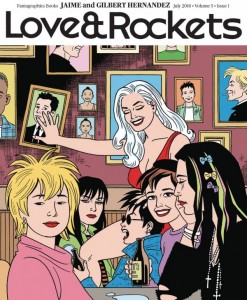 Love and Rockets #1 — Creators: Jaime and Gilbert Hernandez
Love and Rockets #1 — Creators: Jaime and Gilbert Hernandez
One of the few rules around these parts is that Jaime and Gilbert, when they’re a team, automatically go to the top of whatever list they’re on, and the return of this series as a magazine-size, black-and-white periodical is a welcome callback to their ’80s origins. About their third year in, around 1985/1986, when Love and Rockets was on the same lists as Dark Knight Returns, Watchman, Maus and… American Flagg? Anybody else?… as the future of comics, they were just cranking out duel masterpieces every month: Jaime with Maggie and Hopey and their punk-rock band and east-LA milieu; Gilbert with the village of Palomar and Luba and all that creepy, beautifully-textured magic realism. Both are still following those characters, 30 years later, so only use this issue as a sampler: it’s like being at a party where everybody’s got a long shared history with everybody else, and you’re new and don’t know anything about any of them. To see what the fuss is about, go buy the graphic novels: Heartbreak Soup and Human Diastrophism for the Palomar stories, and The Girl From H.O.P.P.E.R.S. and Perla La Loca and Penny Century for the epic, offhandedly-passionate relationship of Maggie and Hopey (Jaime’s had the most steady career — “The Love Bunglers,” in Love and Rockets: New Stories #4, is only five years old and, if you’ve read the other books first, just heart-breakingly perfect).
 Infamous Iron Man #1 — Writer: Brian Michael Bendis; Art: Alex Maleev; Colors: Matt Hollingsworth
Infamous Iron Man #1 — Writer: Brian Michael Bendis; Art: Alex Maleev; Colors: Matt Hollingsworth
Doctor Strange #13 — Writer: Jason Aaron; Pencils: Chris Bachalo; Inks: Five Guys; Colors: Antonio Fabela and Java Tartaglia with Bachalo
Black Panther #7 — Writer: Ta-Nehisi Coates; Pencils/Layouts: Chris Sprouse; Inks/Finishes: Karl Story; Colors: Laura Martin
Amazing Spider-Man #20 — Writers: Dan Slott and Christos Gage; Pencils: Giuseppe Camuncoli; Inks: Cam Smith and Camuncoli; Colors: Jason Keith
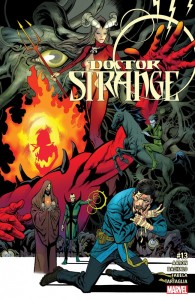 Death of X #2 (of 4) — Writers: Jeff Lemire and Charles Soule; Pencils: Aaron Kuder; Inks: Jay Leisten with Cam Smith and Scott Hanna; Colors: Morry Hollowell and Jay David Ramos
Death of X #2 (of 4) — Writers: Jeff Lemire and Charles Soule; Pencils: Aaron Kuder; Inks: Jay Leisten with Cam Smith and Scott Hanna; Colors: Morry Hollowell and Jay David Ramos
Powers #7 — Writer: Brian Michael Bendis; Art: Michael Avon Oeming; Colors: Nick Filardi
Lots of Marvel books this week (as usual), but only one first issue: Infamous Iron Man, with Victor Von Doom putting on the armor. This book’s already gotten some notoriety, since it takes place “after” Civil War II, and there’s a comment in it that indicates that series ended very badly for Tony Stark, but, really, that’s not exactly a surprise, and we all know that, eventually, the status quo will reassert itself. In the meantime, though, 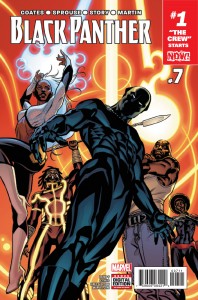 long-time collaborators Bendis and Maleev offer a good-looking and detail-packed debut showcasing the “new” Von Doom: a flashback to the Dark Reign/Cabal days, a present-day scene with Diablo, a sort-of encounter with Tony Stark, and a last-page surprise reveal. The former-bad-guy-trying-to-do-good stuff is effective, and Maleev’s art is always worth a look; add in the curiosity about Marvel’s after-CWII plans, and this comic should do well. Doctor Strange also benefits from an experienced, and top-tier, writer/artist combo, as Aaron and Bachalo offer the continuing adventures of a Stephen Strange who’s dealing with an altered world of magic, where the rules have changed, the old spells often don’t work, and yet foes like Baron Mordo and Nightmare still need to be confronted and somehow defeated. The gritty magic-noir set-up offers a refreshingly new direction, while retaining the wonder and other-dimensional sweep of the best of the older stories,
long-time collaborators Bendis and Maleev offer a good-looking and detail-packed debut showcasing the “new” Von Doom: a flashback to the Dark Reign/Cabal days, a present-day scene with Diablo, a sort-of encounter with Tony Stark, and a last-page surprise reveal. The former-bad-guy-trying-to-do-good stuff is effective, and Maleev’s art is always worth a look; add in the curiosity about Marvel’s after-CWII plans, and this comic should do well. Doctor Strange also benefits from an experienced, and top-tier, writer/artist combo, as Aaron and Bachalo offer the continuing adventures of a Stephen Strange who’s dealing with an altered world of magic, where the rules have changed, the old spells often don’t work, and yet foes like Baron Mordo and Nightmare still need to be confronted and somehow defeated. The gritty magic-noir set-up offers a refreshingly new direction, while retaining the wonder and other-dimensional sweep of the best of the older stories, 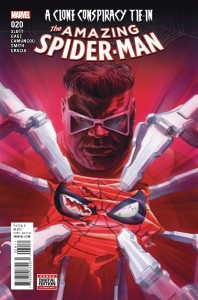 and, as with Maleev, I could look at Bachalo’s art all day. Yet another last-page character reveal should bring all the readers of this issue back for the next, too. Black Panther, meanwhile, after a first arc that focused almost entirely on Wakanda and its inner politics, begins its second with a bunch of guest stars: T’Challa has called in old colleagues like Luke Cage, Manifold, Misty Knight and (intriguingly, given their complicated history) Storm to help him kick butt and take names. After getting past a lot of scene-setting and tone-establishing in its first few issues, this book has settled down into a flashy, smart political/super-powered thriller, with Coates getting more and more confident in his storytelling with each issue; if you turned away from it early on, this is a good place to pick it up again. Amazing Spider-Man features the return of the classic version of Otto Octavius,
and, as with Maleev, I could look at Bachalo’s art all day. Yet another last-page character reveal should bring all the readers of this issue back for the next, too. Black Panther, meanwhile, after a first arc that focused almost entirely on Wakanda and its inner politics, begins its second with a bunch of guest stars: T’Challa has called in old colleagues like Luke Cage, Manifold, Misty Knight and (intriguingly, given their complicated history) Storm to help him kick butt and take names. After getting past a lot of scene-setting and tone-establishing in its first few issues, this book has settled down into a flashy, smart political/super-powered thriller, with Coates getting more and more confident in his storytelling with each issue; if you turned away from it early on, this is a good place to pick it up again. Amazing Spider-Man features the return of the classic version of Otto Octavius,  Doctor Octopus (not a spoiler, considering that cover to the upper left over there), and is a companion piece to last week’s Clone Conspiracy, showing how the Jackal achieved that book’s last-page Doc Ock appearance. For fans who remember the Doc-in-Spidey’s brain Superior Spider-Man days, there’s some clever finessing of the events then, and since Slott/Camuncoli were doing those tales too, there’s an appealingly-seamless continuity to the whole thing; Amazing Spider-Man just keeps chugging along, from arc to arc, a textbook example of how to keep a mainstream franchise interesting and successful. Death of X has been a harder sell for me — a mini-series set months in the Marvel “past,” showing what happened between Cyclops, the X-Men and the Inhumans, seems like old news — but the high-powered co-writing team of Lemire and Soule is keeping me reading,
Doctor Octopus (not a spoiler, considering that cover to the upper left over there), and is a companion piece to last week’s Clone Conspiracy, showing how the Jackal achieved that book’s last-page Doc Ock appearance. For fans who remember the Doc-in-Spidey’s brain Superior Spider-Man days, there’s some clever finessing of the events then, and since Slott/Camuncoli were doing those tales too, there’s an appealingly-seamless continuity to the whole thing; Amazing Spider-Man just keeps chugging along, from arc to arc, a textbook example of how to keep a mainstream franchise interesting and successful. Death of X has been a harder sell for me — a mini-series set months in the Marvel “past,” showing what happened between Cyclops, the X-Men and the Inhumans, seems like old news — but the high-powered co-writing team of Lemire and Soule is keeping me reading,  as is this book’s central connection to the shape of the current Marvel universe (especially considering that it’s a cornerstone to the looming I Vs. X early-2017 event). That leaves Powers, which returns after a months-long hiatus to begin a new arc set in Walker’s past, where he’s a boxcar-riding amnesiac beset by old enemies he doesn’t even recognize. It’s an insider-centric plot, one that might confuse new fans, and it doesn’t play to the crime noir/super-police-procedural spine of the concept, which is a Bendis strength, but the typically-stylized art from Oeming is always a sleek treat, and there’s yet another last-page character reveal that should bring this comic’s readers back, too — whenever the next issue finally comes out.
as is this book’s central connection to the shape of the current Marvel universe (especially considering that it’s a cornerstone to the looming I Vs. X early-2017 event). That leaves Powers, which returns after a months-long hiatus to begin a new arc set in Walker’s past, where he’s a boxcar-riding amnesiac beset by old enemies he doesn’t even recognize. It’s an insider-centric plot, one that might confuse new fans, and it doesn’t play to the crime noir/super-police-procedural spine of the concept, which is a Bendis strength, but the typically-stylized art from Oeming is always a sleek treat, and there’s yet another last-page character reveal that should bring this comic’s readers back, too — whenever the next issue finally comes out.
 The Mighty Thor #12 — Writer: Jason Aaron; Art: Russell Dauterman and Frazer Irving; Colors: Matthew Wilson and Irving
The Mighty Thor #12 — Writer: Jason Aaron; Art: Russell Dauterman and Frazer Irving; Colors: Matthew Wilson and Irving
Black Widow #7 — Writers: Mark Waid and Chris Samnee; Art: Chris Samnee; Colors: Mathew Wilson
Spider-Woman #12 — Writer: Dennis Hopeless; Art: Tigh Walker; Colors: Rachelle Rosenberg
The Unbeatable Squirrel Girl #13 — Writer: Ryan North; Art: Erica Henderson; Colors: Rico Renzi
Hellcat #11 — Writer: Kate Leth; Art: Brittney L. Williams; Colors: Rachelle Rosenberg
 Marvel’s developed a deep bench of titles with female leads over the last few years, and they tend to break into two types: traditional super-hero books by well-known, mainstream writers and artists, and more modern-looking comics by newer creators, often breezy and brightly-colored, pitched at a slightly younger and more diverse audience. Of the traditional books, Thor has been the most successful, with Aaron offering an appealing, courageous version of Jane Foster as the Goddess of Thunder, and integrating her seamlessly into his Earth/Asgardian/Nine Realms stew of immortals, trolls, dark and light elves, minotaur CEOs, and comic-relief S.H.I.E.L.D. agents. This issue follows up on the clever reveal of the last one — that
Marvel’s developed a deep bench of titles with female leads over the last few years, and they tend to break into two types: traditional super-hero books by well-known, mainstream writers and artists, and more modern-looking comics by newer creators, often breezy and brightly-colored, pitched at a slightly younger and more diverse audience. Of the traditional books, Thor has been the most successful, with Aaron offering an appealing, courageous version of Jane Foster as the Goddess of Thunder, and integrating her seamlessly into his Earth/Asgardian/Nine Realms stew of immortals, trolls, dark and light elves, minotaur CEOs, and comic-relief S.H.I.E.L.D. agents. This issue follows up on the clever reveal of the last one — that  the hammer Mjolnir is sentient — and goes deep into Odin’s past to explain it, in a way that’s typically entertaining, cinematic and good-looking all at once. Black Widow boasts the A-level team of Waid and Samnee, and its first arc started with a bang-up full-issue action sequence, and then got into typically-murky spy-vs.-spy stuff, all inter-related with Natasha’s past, that started to lose me; it came back strong at the end, though, and this new sequence, which builds on the end of that one, bows to its main character’s bloody, terrible past while still making her, against all odds, heroic — and doing it with Samnee’s usual super-slick style. Spider-Woman hooked me with its first episodes about a
the hammer Mjolnir is sentient — and goes deep into Odin’s past to explain it, in a way that’s typically entertaining, cinematic and good-looking all at once. Black Widow boasts the A-level team of Waid and Samnee, and its first arc started with a bang-up full-issue action sequence, and then got into typically-murky spy-vs.-spy stuff, all inter-related with Natasha’s past, that started to lose me; it came back strong at the end, though, and this new sequence, which builds on the end of that one, bows to its main character’s bloody, terrible past while still making her, against all odds, heroic — and doing it with Samnee’s usual super-slick style. Spider-Woman hooked me with its first episodes about a 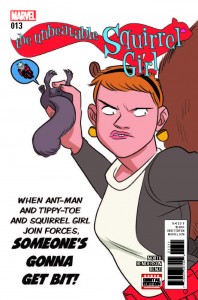 pregnant Jessica battling Skrulls and giving birth, and then a second sequence with some very realistic single-mom-with-infant bits skillfully intertwined with the regular fighting-super-villains stuff. The last few issues have been about her breaking up with old friend Carol Danvers, and exhibited some Civil War II fatigue, but this issue’s one-shot tale — Jessica and her friend/nanny, Roger, take their kids to the beach and run into, of course, the Sandman — makes up for it. Roger’s also the reformed bad guy the Porcupine — and, yes, I know that sounds stupid, but read this issue and you’ll see exactly the kind of clever characterization, action, and warmth that make the book work so well. Of the more modern-reader-oriented comics, Squirrel Girl has been the standard bearer: Erica Henderson’s art is funny, minimalist perfection, every line exactly
pregnant Jessica battling Skrulls and giving birth, and then a second sequence with some very realistic single-mom-with-infant bits skillfully intertwined with the regular fighting-super-villains stuff. The last few issues have been about her breaking up with old friend Carol Danvers, and exhibited some Civil War II fatigue, but this issue’s one-shot tale — Jessica and her friend/nanny, Roger, take their kids to the beach and run into, of course, the Sandman — makes up for it. Roger’s also the reformed bad guy the Porcupine — and, yes, I know that sounds stupid, but read this issue and you’ll see exactly the kind of clever characterization, action, and warmth that make the book work so well. Of the more modern-reader-oriented comics, Squirrel Girl has been the standard bearer: Erica Henderson’s art is funny, minimalist perfection, every line exactly  in place and nothing wasted, a style Alex Toth would have loved, while Ryan North’s scripts show a compassionate, highly-competent, sometimes-flawed but always-optimistic heroine who thinks her way out of trouble, pops bad-guy cliches by trying to reason with them (and then making friends with the ones who listen and totally kicking the butts of the ones who don’t), and really, truly is unbeatable. Hellcat has a similar rejection of regular punch’eminnaface super-hero cliches, and a similar kick-ass heroine and light tone; that’s complemented by Brittney Williams’s cartoony manga-style art: a bright, precise combination of humor and action that matches Kate Leth’s smart scripts just right.
in place and nothing wasted, a style Alex Toth would have loved, while Ryan North’s scripts show a compassionate, highly-competent, sometimes-flawed but always-optimistic heroine who thinks her way out of trouble, pops bad-guy cliches by trying to reason with them (and then making friends with the ones who listen and totally kicking the butts of the ones who don’t), and really, truly is unbeatable. Hellcat has a similar rejection of regular punch’eminnaface super-hero cliches, and a similar kick-ass heroine and light tone; that’s complemented by Brittney Williams’s cartoony manga-style art: a bright, precise combination of humor and action that matches Kate Leth’s smart scripts just right.
 Cave Carson Has a Cybernetic Eye #1 — Writers: Gerard Way and Jon Rivera; Art: Michael Avon Oeming; Colors: Nick Filardi
Cave Carson Has a Cybernetic Eye #1 — Writers: Gerard Way and Jon Rivera; Art: Michael Avon Oeming; Colors: Nick Filardi
Trinity #2 — Writer/Artist/Colors: Francis Manapul
Superman #9 — Writers: Peter J. Tomasi and Patrick Gleason; Pencils: Doug Mahnke; Inks: Jaime Mendoza and Trevor Scott; Colors: Wil Quintana
Batman #9 — Writer: Tom King; Art: Mikel Janin; Colors: June Chung
DKIII: The Master Race #6 (of 8 )– Writers: Brian  Azarello with Frank Miller; Pencils: Andy Kubert; Inks: Klaus Janson; Colors: Brad Anderson
Azarello with Frank Miller; Pencils: Andy Kubert; Inks: Klaus Janson; Colors: Brad Anderson
Lucifer #11 — Writer: Holly Black; Art: Lee Garbett; Colors: Antonio Fabela
Astro City #40 — Writer: Kurt Busiek; Art: Carmen Carnero; Colors: Peter Pantazis
Of the DC books, the notable debut is Cave Carson Has a Cybernetic Eye, the third book from the Young Animal imprint helmed by Gerard Way. It doesn’t have the whiplash surreality of Doom Patrol, but it’s a good example of how much Way has studied the early years of Vertigo: 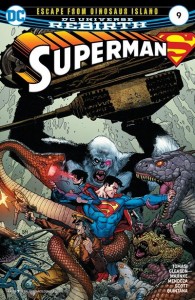 take an obscure DC character (Cave fits in nicely with the likes of Animal Man, Prez, the Tattoed Man, and Black Orchid, all of whom were featured in Vertigo titles), mix in a quirky but accomplished artist (in this case, Michael Avon Oeming), add a script that nods to the character’s early history but modernizes and updates it (magma trolls are name-checked on the very first page, but the Cave here is coping with the death of his wife, and has a grown daughter, and of course there’s that eye…), and stir in a few other bits of DC continuity (Doc Magnus gets a couple of pages, and the Metal Men have a cameo; plus, there’s another of those ubiquitous last-page reveals of an even-more obscure character that’s sure to send everyone to the back-issue bins and drive up his first appearance). I wasn’t
take an obscure DC character (Cave fits in nicely with the likes of Animal Man, Prez, the Tattoed Man, and Black Orchid, all of whom were featured in Vertigo titles), mix in a quirky but accomplished artist (in this case, Michael Avon Oeming), add a script that nods to the character’s early history but modernizes and updates it (magma trolls are name-checked on the very first page, but the Cave here is coping with the death of his wife, and has a grown daughter, and of course there’s that eye…), and stir in a few other bits of DC continuity (Doc Magnus gets a couple of pages, and the Metal Men have a cameo; plus, there’s another of those ubiquitous last-page reveals of an even-more obscure character that’s sure to send everyone to the back-issue bins and drive up his first appearance). I wasn’t 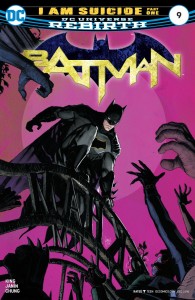 completely enamored with Shade, the Changing Woman, although I’m happy to give it a few more issues, but Doom Patrol and Cave Carson are clever, energetic, ground-breaking fun, and I hope they’re around for the next decade or two. Trinity is traditional mainstream super-hero storytelling, featuring, of course, the Big Three of Superman, Batman and Wonder Woman — with the twist that this is the new Superman, so the other two don’t know him very well, and are suspicious of his motives. This second issue continues from the first, where the trio, after a dinner with Clark, Lois and son, have seemingly time-travelled into the past to encounter Jonathan Kent and a young Clark. What’s really going on? Read it and see…
completely enamored with Shade, the Changing Woman, although I’m happy to give it a few more issues, but Doom Patrol and Cave Carson are clever, energetic, ground-breaking fun, and I hope they’re around for the next decade or two. Trinity is traditional mainstream super-hero storytelling, featuring, of course, the Big Three of Superman, Batman and Wonder Woman — with the twist that this is the new Superman, so the other two don’t know him very well, and are suspicious of his motives. This second issue continues from the first, where the trio, after a dinner with Clark, Lois and son, have seemingly time-travelled into the past to encounter Jonathan Kent and a young Clark. What’s really going on? Read it and see… 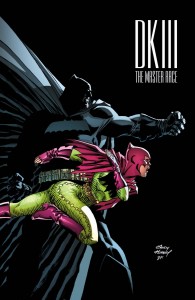 and, again, wait for the last-page everything-you-thought-is-wrong reveal. Meanwhile, the regular Superman and Batman books roll merrily along, with all that Rebirth business having energized them: Superman sees Clark and Son encountering Dinosaur Island and the Losers (well, one of them), in a salute to DC’s war comics; the Doug Mahnke art, as always, is a selling point. Batman continues to benefit from the scripting of Tom King, who’s turning out to be a worthy successor to Scott Snyder; here, the Dark Knight is planning a raid on Bane’s island fortress, and, sanctioned by Amanda Waller, is putting together his own version of the Suicide Squad, taken solely from the inmates at Arkham Asylum. That’s one of those plots that makes you want to read the comic all
and, again, wait for the last-page everything-you-thought-is-wrong reveal. Meanwhile, the regular Superman and Batman books roll merrily along, with all that Rebirth business having energized them: Superman sees Clark and Son encountering Dinosaur Island and the Losers (well, one of them), in a salute to DC’s war comics; the Doug Mahnke art, as always, is a selling point. Batman continues to benefit from the scripting of Tom King, who’s turning out to be a worthy successor to Scott Snyder; here, the Dark Knight is planning a raid on Bane’s island fortress, and, sanctioned by Amanda Waller, is putting together his own version of the Suicide Squad, taken solely from the inmates at Arkham Asylum. That’s one of those plots that makes you want to read the comic all  by itself, and in this first episode we see Batman picking out his crew: lots of familiar faces for old fans, and a good start to this next adventure. The other bat-book, DKIII, offers the antepenultimate (hey… Google it…) chapter of its tale of hundreds of religious-cult Kryptonians released from Kandor and wreaking havoc on a couple-of-decades-in-the-future Gotham City, opposed by this timeline’s versions of Superman, Batman and Carrie. There’s one of the usual inserts, too, with Miller/Janson art on a fight between Wonder Woman and her daughter; this is one of those books that you’re either already buying or you’re not, and at this point my recommendation won’t make any difference. Lucifer continues to be surprisingly good, as this issue reintroduces a number of characters and concepts from the original
by itself, and in this first episode we see Batman picking out his crew: lots of familiar faces for old fans, and a good start to this next adventure. The other bat-book, DKIII, offers the antepenultimate (hey… Google it…) chapter of its tale of hundreds of religious-cult Kryptonians released from Kandor and wreaking havoc on a couple-of-decades-in-the-future Gotham City, opposed by this timeline’s versions of Superman, Batman and Carrie. There’s one of the usual inserts, too, with Miller/Janson art on a fight between Wonder Woman and her daughter; this is one of those books that you’re either already buying or you’re not, and at this point my recommendation won’t make any difference. Lucifer continues to be surprisingly good, as this issue reintroduces a number of characters and concepts from the original  series — that Mike Carey-scribed, 75-issue tale was a hard act to follow, but Holly Black is up to the job here, as the title character gathers his forces to fight his father, who, having been murdered and resurrected, has become a lot more Old Testament-y vengeful than before. No small thinking here, and the cosmic sweep of the story carries it along nicely. That leaves Astro City, one of the most dependably-good comics out there; this conclusion to a two-part story involving a woman who becomes a lawyer to the enhanced-powers crowd has exactly the kind of offhand focus — on the regular denizens and support people and workers of its title town, and not the heroes themselves — that’s always made this comic both unique and compelling.
series — that Mike Carey-scribed, 75-issue tale was a hard act to follow, but Holly Black is up to the job here, as the title character gathers his forces to fight his father, who, having been murdered and resurrected, has become a lot more Old Testament-y vengeful than before. No small thinking here, and the cosmic sweep of the story carries it along nicely. That leaves Astro City, one of the most dependably-good comics out there; this conclusion to a two-part story involving a woman who becomes a lawyer to the enhanced-powers crowd has exactly the kind of offhand focus — on the regular denizens and support people and workers of its title town, and not the heroes themselves — that’s always made this comic both unique and compelling.
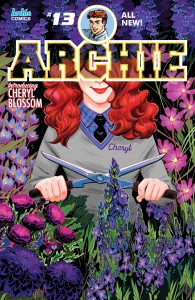 Archie #13 — Writer: Mark Waid; Art: Joe Eisma; Colors: Andre Szymanowicz
Archie #13 — Writer: Mark Waid; Art: Joe Eisma; Colors: Andre Szymanowicz
Dept.H #7 — Writer/Artist: Matt Kindt; Colors: Sharlene Kindt
 War Stories #20 — Writer: Garth Ennis; Art: Tomas Aira; Colors: Digikore Studios
War Stories #20 — Writer: Garth Ennis; Art: Tomas Aira; Colors: Digikore Studios
I Hate Fairyland #10 — Writer/Artist: Skottie Young; Colors: Jean-Francois Beaulieu
 Usagi Yojimbo #158 — Creator: Stan Sakai
Usagi Yojimbo #158 — Creator: Stan Sakai
We’re already well over 2300 words with all that Love and Rockets gushing, so quickly: Archie starts a new arc with Veronica in a boarding school in Switzerland and reintroduces Cheryl Blossom as a student there; the new artist is fine, but it’s Mark Waid whose scripting is holding this series together (and his 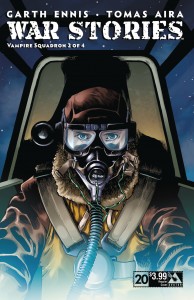 essays introducing the reprints — in this case, C.B.’s first appearance — are great bits of comics history). Dept.H. is Matt Kindt’s creator-owned, deceptively-primitive-looking and inventive “murder six miles deep” mystery. I Hate Fairyland is Skottie Young’s gleefully-anarchic piss-take of the magical kingdom/Wizard of Oz genre. War Stories is in the middle of a four-part story about
essays introducing the reprints — in this case, C.B.’s first appearance — are great bits of comics history). Dept.H. is Matt Kindt’s creator-owned, deceptively-primitive-looking and inventive “murder six miles deep” mystery. I Hate Fairyland is Skottie Young’s gleefully-anarchic piss-take of the magical kingdom/Wizard of Oz genre. War Stories is in the middle of a four-part story about 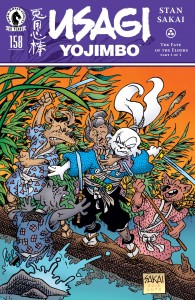 R.A.F. fighter pilots defending Britain during WWII, as stiff-upper-lip historically accurate as Ennis’s detailed knowledge of that era can make it. Usagi Yojimbo features even more precise research, plus a love of Japanese cinema, to create its tales of Japan’s Edo period in the 1600s, the time of samurais and wandering ronin, as populated by anthropomorphic characters like its rabbit warrior. This issue, like most, has a one-shot tale, masterfully told, involving an encounter with an elderly peasant couple on a grim journey to help their famine-stricken village. Sample it, and let it introduce you to over thirty years of similarly-skillful storytelling.
R.A.F. fighter pilots defending Britain during WWII, as stiff-upper-lip historically accurate as Ennis’s detailed knowledge of that era can make it. Usagi Yojimbo features even more precise research, plus a love of Japanese cinema, to create its tales of Japan’s Edo period in the 1600s, the time of samurais and wandering ronin, as populated by anthropomorphic characters like its rabbit warrior. This issue, like most, has a one-shot tale, masterfully told, involving an encounter with an elderly peasant couple on a grim journey to help their famine-stricken village. Sample it, and let it introduce you to over thirty years of similarly-skillful storytelling.



